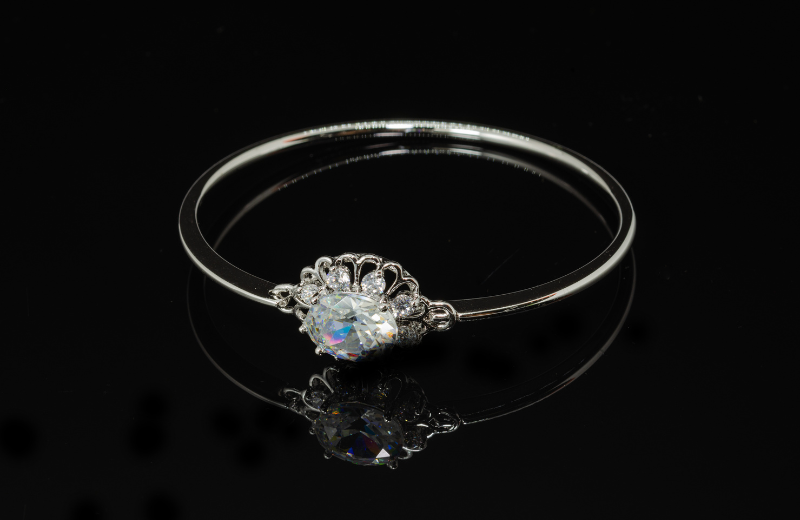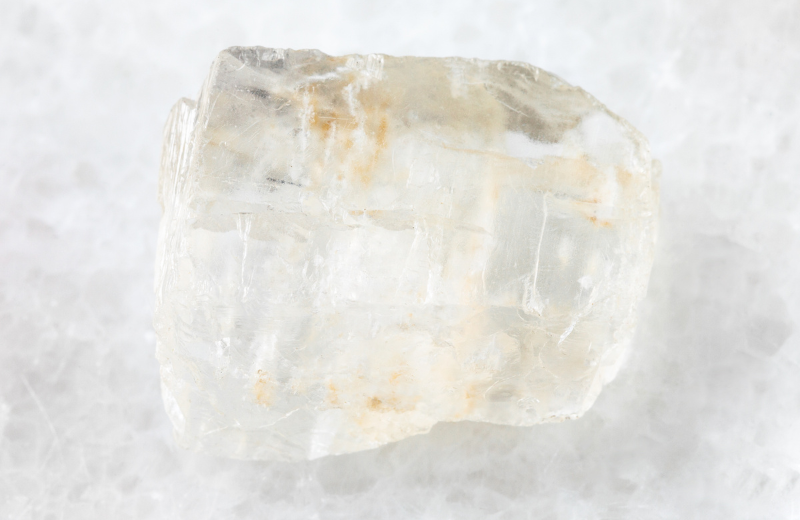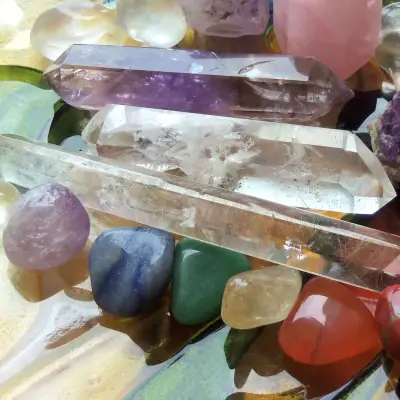Are you fascinated by crystals and their unique properties? Whether you’re a seasoned crystal enthusiast or a curious newcomer, petalite might be the stone that catches your interest. Known for its delicate beauty and remarkable benefits, petalite has carved a niche in the world of gemstones. Let’s dive into the world of petalite and explore its properties, uses, and role in crystal healing.
Jump To:
What is Petalite?
Petalite is a lithium aluminium phyllosilicate mineral, often recognised for its translucent to transparent quality. It’s frequently used in crystal healing for its high vibration and ability to connect the physical and spiritual realms. It is often called the "Stone of Angels" due to its reputed capacity to facilitate angelic communication. Meditators and spiritual practitioners value petalite for its ability to deepen meditation, enhance spiritual awareness, and support connection with higher consciousness.
Petalite Colour Variations
Petalite can range from colourless to grey, yellow, or even blue, although pink petalite is the most prized due to its stunning, delicate hue. The colour of petalite can influence its value and appeal, especially in the jewellery market.
Recommended for you!
Best SellersPetalite Properties

Petalite is a fascinating mineral known for its unique characteristics and uses. Let’s delve into its physical and protective properties to understand why it stands out in the world of gemstones.
Physical Properties
Petalite is a mineral that typically forms in pegmatites, which are coarse-grained igneous rocks. It has a hardness of 6 to 6.5 on the Mohs scale, making it relatively durable but not as hard as some other gemstones like diamonds or sapphires. The crystal system of petalite is monoclinic, and it often forms in prismatic or tabular crystals.
Protective Properties
Another significant aspect of petalite is its reputed protective properties. It is believed to create a protective shield around the user, warding off negative energies and psychic attacks. This makes it an excellent stone for those who are sensitive to environmental or emotional stressors, providing a sense of security and grounding.
Uses of Petalite

Petalite’s versatility extends beyond its beauty as a gemstone. It plays an essential role in various industrial applications and is highly valued in spiritual practices. Here’s a closer look at its different uses.
Jewellery
Due to its appealing appearance, petalite is often cut and polished for use in jewellery. Its translucent nature allows light to pass through, creating a beautiful, subtle sparkle that’s perfect for rings, necklaces, and earrings.
Spiritual and Healing Uses
Petalite is highly valued in crystal healing practices for its purported spiritual properties. It is believed to aid in emotional healing, offering peace, tranquillity, and protection. Many users claim that petalite helps with meditation, enhancing spiritual connection and promoting a sense of calm.
Industrial Uses
Petalite is a key source of lithium, which is extracted for use in various industries. Lithium is a vital element in the production of batteries, ceramics, and glass. Extracting lithium from petalite involves crushing the mineral and then using chemical methods to separate the lithium.
Petalite in Crystal Healing
Petalite is cherished in the realm of crystal healing for its alleged emotional, spiritual, and physical benefits. Whether you seek mental clarity or physical wellness, petalite may offer supportive energies.
Emotional and Mental Benefits
Petalite is often used to help alleviate stress and anxiety. Its calming energy is said to provide emotional balance and support, making it a popular choice for those looking to manage their mental well-being.
Spiritual Benefits
In the realm of spirituality, petalite is believed to strengthen one’s connection to higher realms. It is used in meditation to deepen the experience and is thought to assist in achieving a state of enlightenment and understanding.
Physical Healing
While scientific evidence is lacking, many crystal enthusiasts believe that petalite can support physical healing. It is often used to aid in the treatment of issues related to the lungs and the endocrine system.
Chakra Healing
In chakra healing, petalite is associated with the crown and higher crown chakras. Its energy is said to open these chakras, allowing for a stronger connection to spiritual guidance and higher wisdom. By aligning the chakras, petalite helps to create a balanced energy flow, promoting overall harmony and spiritual enlightenment.
Where is Petalite Found?
Petalite deposits are found in several locations around the world, including Brazil, Australia, Sweden, Italy, Namibia, and the United States. Each location may produce petalite with slightly different characteristics due to variations in geological conditions.
Identifying Petalite

To identify petalite, look for its characteristic translucence and colour variations. A jeweller or a geologist can perform tests to confirm its identity, such as examining its crystal structure and conducting a hardness test. Petalite can sometimes be confused with spodumene, another lithium-rich mineral, but they can be distinguished by their differing crystal habits and chemical compositions.
How to Care for Petalite
To maintain your petalite, clean it gently with warm, soapy water and a soft cloth. Avoid exposing it to harsh chemicals or extreme temperatures, which can damage the stone. When not in use, store your petalite jewellery in a soft pouch to prevent scratches.
Read more about how to clean, cleanse and charge your crystals.
How to Tell if Petalite is Real
To determine if petalite is real, start by examining its physical characteristics. Genuine petalite typically exhibits a translucent to transparent quality with a glassy lustre. Its hardness of 6 to 6.5 on the Mohs scale means it can scratch glass but can be scratched by harder materials like quartz. Authentic petalite often forms in prismatic or tabular crystals and may display colours ranging from white, grey, and yellow, to the prized pink.
Read more about how to tell if a crystal is real.
Recommended for you!
Best SellersFrequently Asked Questions about Petalite
Does Petalite come in blue?
Petalite can occur in various colours, including blue, although it is quite rare. The more common colours are white, grey, yellow, and pink. Blue petalite is highly prized among collectors due to its rarity and unique appearance.
Who discovered petalite?
Petalite was discovered by the Brazilian scientist José Bonifácio de Andrada e Silva in 1800. He was a prominent figure in mineralogy and is also credited with the discovery of other minerals.
What powers does petalite have?
In crystal healing, petalite is believed to have several powers. It is thought to promote peace, tranquillity, and emotional balance. Many practitioners use it to alleviate stress and anxiety, aid in meditation, and enhance spiritual connection. It is also considered protective and grounding, making it a versatile stone in the realm of crystal healing.
How rare is petalite?
Petalite is considered relatively rare, especially in gemstone-quality specimens. Pink petalite is particularly rare and sought after due to its beautiful and delicate colour. The rarity can influence the price and desirability of the stone in the market.
Is petalite expensive?
The cost of petalite can vary widely. Factors influencing its price include colour, clarity, size, and overall quality. While some petalite stones can be relatively affordable, high-quality pink petalite or larger, flawless specimens can be quite expensive, sometimes costing hundreds of pounds per carat.
How is lithium extracted from petalite?
Lithium extraction from petalite involves crushing the mineral and then applying a series of chemical processes to separate the lithium from other components. The lithium is then purified and used in various applications, including batteries, ceramics, and glass production.
What is the difference between petalite and spodumene?
While both petalite and spodumene are lithium-bearing minerals, they have different crystal structures and physical properties. Petalite typically forms in tabular or prismatic crystals and has a simpler colour range, while spodumene appears in prismatic crystals and includes varieties like kunzite (pink to lilac) and hiddenite (green). Their chemical compositions also differ, affecting their use and value in different applications.
Is pink petalite rare?
Pink petalite is considered rare and is highly valued for its delicate and attractive colour. Its rarity makes it a sought-after stone for collectors and jewellery makers alike.
If you’re keen to learn more about the world of crystals and their healing properties, consider enrolling in the Crystal Healing Diploma Course with Centre of Excellence. This comprehensive course is available at a discounted price of £29, providing you with valuable knowledge and skills to enhance your crystal healing journey.













